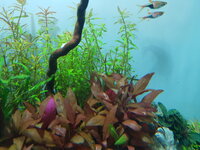Just a thought, but what livestock do you currently have in there? When I set up my current scape, after an initial 2 months ‘honeymoon’ period of really nice, algae free growth, I started to get a few different types of algae that I then struggled to get control of for 2 or 3 months. This seemed to coincide with when I added the first decorative fish to the tank. Not entirely the same as your issues, but the main offender for me was brown fuzzy diatoms, which got onto everything, plants, rocks and worst of all my HC carpet. This stuff was literally suffocating everything in the tank.
After seeking help on here, and feeling like I’d tried everything, I was ready to pick the tank up and throw it out in the garden, my frustration with the situation was that bad.
In the end, everything changed when I put in 3 Siamese algae eaters. Within two weeks all of the fuzz was gone.
I’m not 100 percent sure whether these fish solved my my problem, or whether or not it was just coincidence that the diatoms started to disappear shortly after adding them, or a mixture of both. But the anecdotal evidence was that they played a big part. They would visibly eat the fuzzy brown algae. Im wondering perhaps, if these fish might eat the green fuzzy stuff that you have growing?
Don’t get me wrong, even if they did clear the fuzz, they aren’t a cure for the root cause, but for me, getting rid of the fuzzy coating to everything allowed me to get back control of my tank, and allowed it to grow better again.
This then allowed me to address the other algae issues I had.



